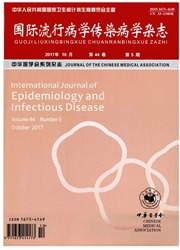

 中文摘要:
中文摘要:
目的分析研究H5N6人禽流感病毒基因组序列特征,明确该病毒的分子进化及生物学特性。方法从GenBank和GISAI中获取人H5N6分离株全序列,通过软件BioEdit7.0.9对各节段基因与其他相关毒株序列进行比对。用软件Mega5.0,Neighbor—Joining法绘制血凝素(HA)和神经氨酸酶(NA)基因进化树,并全面分析病毒株的基因组序列特征、病毒进化及来源、传染性、致病性和药物敏感等。结果H5N6病毒的基因组完全属于禽源特征,根据病毒进化及来源可分为两大类。HA基因都属于H5亚型的2.3.4.4进化支,NA基因都来源于H6N6亚型毒株,属于欧亚谱系。其余6段内部基因分别来自于H9N2亚型或H5亚型2.3.2.1进化支毒株。该病毒尚不能在人与人之间有效传播,呈现高致病性病毒特征,对奥斯他韦敏感,但部分毒株对金刚烷胺类药物耐药。结论H5N6人禽流感分离株并不属于同一毒株,是由H5N1、H5N2、H6N6、H9N2等亚型毒株通过不同组合而重配产生,需加强对这类病毒及其宿主的监控。
 英文摘要:
英文摘要:
Objective To analyze the genome sequences of the human H5N6 avain influenza virus (AIV), so as to elucidate its evolution status and biological characteristics. Methods Genomes of human infected isolates of AIV HSN6 were collected from GenBank and GISAI. The nucleotide sequences were blasted with the referenced influenza viruse isolates by BioEdit7.0.9 software. The phylogenetic trees of hemagglutinin (HA) and neuramidinase (NA) were constructed by Mega 5.0 software and the neighbor-joining method ; and the sequence characteristics, the molecular evolution, infectivity, pathogenicity and drug susceptibility of the viruses were analyzed. Results The HSN6 isolates were typical avian influenza viruses according to the genome sequences and they were derided into two groups based on the genetic evolution. Homology and phylogenetic analysis showed that the HA genes belonged to clade 2.3.4.4 of H5 AIVs, and the NA genes were derived from H6N6 virus which belonged to Eurasia lineage. The other six internal genes were derived from subtype H9N2 virus or clade 2.3.2.1 of H5 AIVs. The viruses couldn't spread by person-to-person effectively and possessed high pathogenicity. The viruses were sensitive to osehamivir, but partial isolates were resistant to amantadine and remantadine. Conclusions The HSN6 isolates are very heterogeneous and are involved in genetic reassortment with H5N1, HSN2, H6N6 and H9N2 AIVs. Therefore, the surveillance for these viruses and their hosts should be further strengthened.
 同期刊论文项目
同期刊论文项目
 同项目期刊论文
同项目期刊论文
 期刊信息
期刊信息
